The Contest
The year 2022 marks the 50th anniversary of Kinze producing two-wheel grain carts. After building a prototype cart in 1971, Jon Kinzenbaw manufactured the first production run of eight, 400-bushel grain carts and quickly sold them all. Whatever happened to these carts? Any chance that one of them might still be around? We really wanted to know the answers to these questions, which gave birth to the Oldest Running Cart Contest we conducted from November 15 to December 31, 2021. In this contest, not only were we looking for the oldest operating grain cart, but we also wanted all our customers to brag a bit about the trusted grain carts they had been using. While many fine vintage Kinze grain carts were submitted, there were some definite surprises along the way. Here’s the story . . .
The Beginning
Grain carts have been staples of the Kinze product line since the very beginning, and few can match the contributions Kinze has made in shaping the way farmers transport and handle grain. It all started in 1967, the year Jon Kinzenbaw built his first auger-unloading grain wagon. Equipped with a PTO-driven transmission and rear axle, it enabled large loads of grain to be moved out of difficult field harvest conditions. Though it may not have been a great commercial success, it helped set the stage for the game-changing product Kinze would introduce a few years later.
A local farmer visited the shop one day to discuss with Jon the trouble he had during the previous harvest. Wet grounds, he complained, had forced him to haul corn out of the field using a small feed wagon – one typically used in the barnyard. Moving 50 bushels at a time three-quarters of a mile to the road had added hours, if not days, to harvest. Thus, the farmer sought a bigger, better, faster way to move grain across soft fields. Ideally, something that could haul at least 400 bushels.
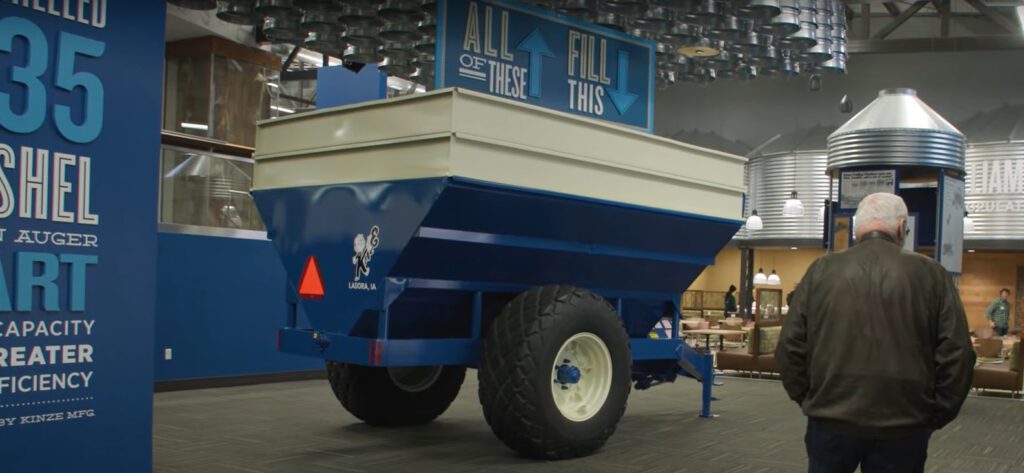
What Jon Developed was a giant-capacity (435 bu.), low-profile cart featuring large diameter augers for fast unloading, and two high-flotation tires on a single axle for superior mobility. This exclusive design set a new, higher standard for speed and performance in grain handling. The farmer was ecstatic and word about the Kinze two-wheel grain cart quickly spread. Farmers could finally move huge volumes of grain from the combine to standing trucks with relative ease, even in unfavorable harvest conditions.
The Production Run
In 1965, Jon started Kinze Welding in a small concrete block building located in Ladora, Iowa. By 1969, he needed additional room for mass-producing 30-foot folding anhydrous applicators, so Jon constructed a new 50′ x 100′ building for additional production space. Fortunately, this space was already in place when, in 1972, Jon began on the first production run of eight, 400-bushel grain carts. These went into production so quickly after producing a successful prototype that they didn’t even have serial numbers!
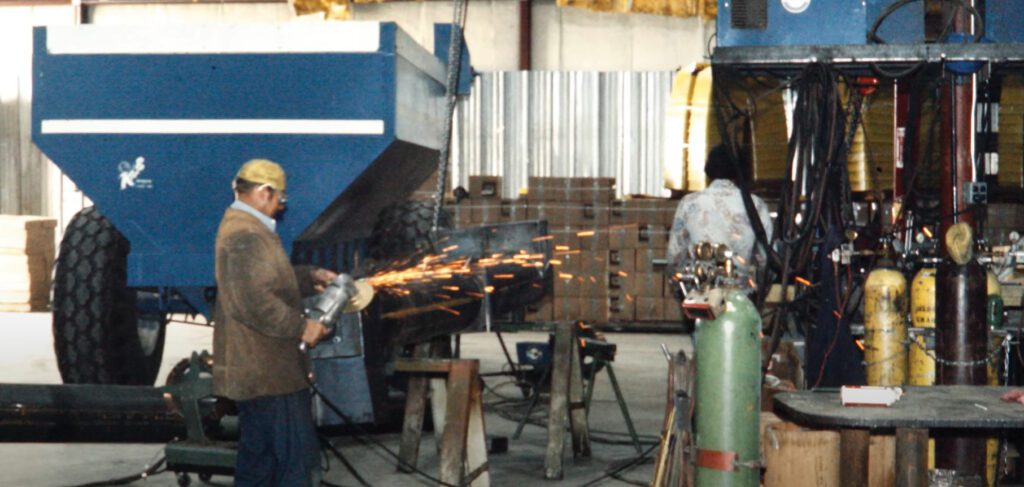
Back then, Kinze Welding’s production area was not anything like a modern Kinze factory with its designated function areas and an assembly line. Instead, cutting, machining, grinding, welding, painting, and assembly all took place in the same large area, and everyone worked on whatever was the next best thing in the process. By the end of the build, there were eight new carts ready for sale to local farmers.
One of the farmers that soon stopped by to pick up his new cart was Dan Stadtmueller . . .
The Original Owner
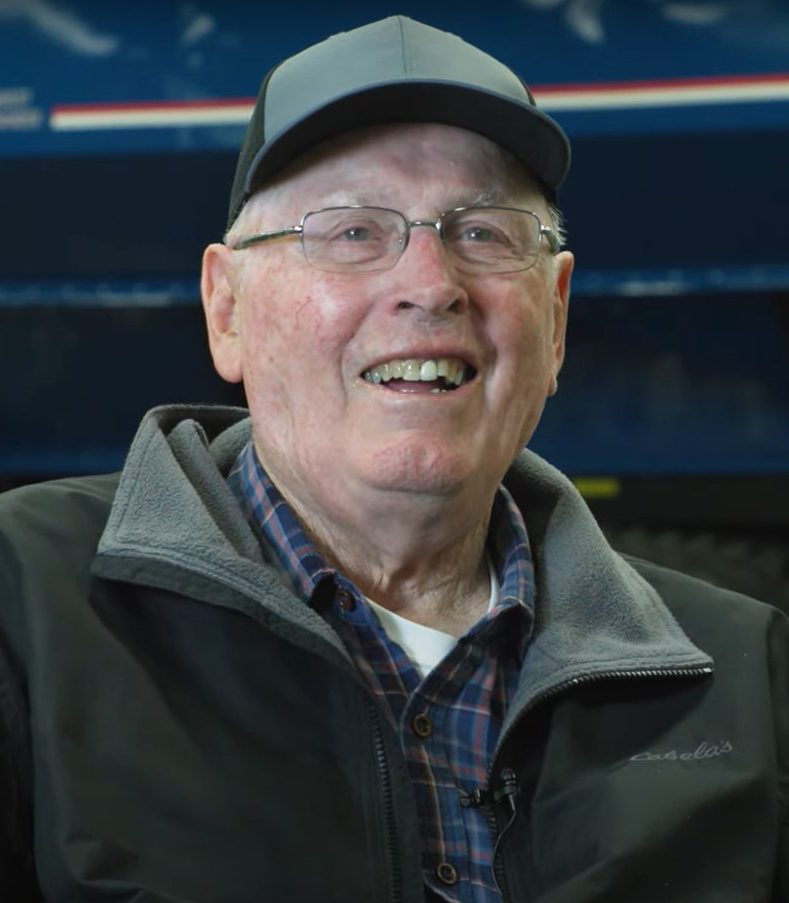
Dan, a retired farmer from Monticello, Iowa, recalls at the time he purchased one of Jon’s first grain carts: “We were expanding our farm at the time and put in a big dump-pit, and so we talked to Jon and he got us a cart. His reputation was very good, and I knew he was on the forefront of this type of thing.”
As it was, Jon’s reputation also meant he personally stood behind his product. “Took [the cart] to the field for the first load, I had it filled with corn and drove up to a truck, and turned on the power take-off and nothing happened,” Dan remembers. “I called up Jon and he came then late in the day. We figured out what the trouble was and we got ‘er done. It was about 10 or 11 o’clock and he had it welded back together and we went into the house and had something to eat.”
Dan recalls these early days doing business with Jon with a sparkle in his eye and a grin on his face. He mentions that he does not recall what he paid for this first cart, but others around him suggest it was priceless – he agrees with a round of laughter.
After several years of operating that first cart, Dan traded it off because his farming operation was getting larger. Years later, it migrated to Kentucky and was listed for sale on Tractor House . . .
The Winner from Kentucky

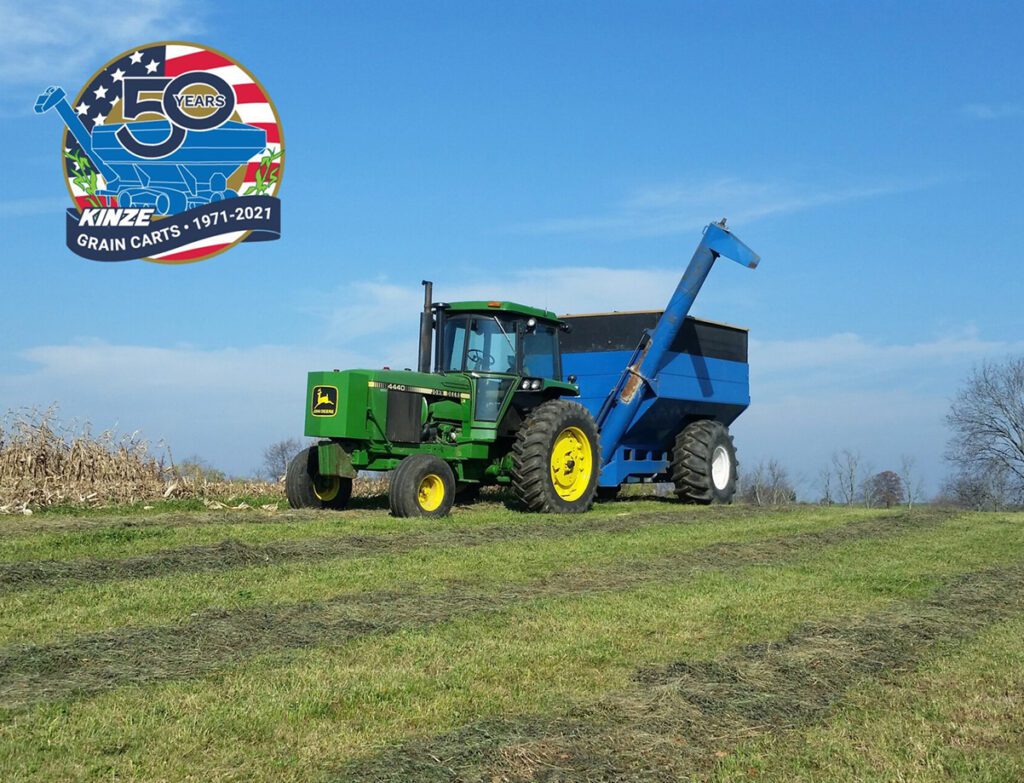
Michael Douglas is from Henry County, Kentucky where he farms with his dad and operates a welding and repair shop.
“I think it was 2014 . . . [the cart] was listed on Tractor House at a dealer in Lancaster, Kentucky,” recalls Michael. He further explains that at that time they had just purchased a semi to haul grain, but was it getting stuck in the field. Finding a solution for getting grain to the road was important for a successful harvest, so they found the Kinze cart.
When he had an auger component wear out, he reached out to AgTalk for advice on how to fix it. It was online that he connected with Dan Stadtmueller’s son who explained the history of the cart. So when the Oldest Running Cart Contest was announced, he realized the significance of his grain cart and knew he needed to enter.
“Only had the one breakdown. Other than that, I check the oil in the gearbox, hook onto it and go, that’s about it,” says Michael. Then he adds, “I’ve got a grain cart that’s 50 years old and it’s still in the field, so it’s pretty high quality. For the longest time, I didn’t know the history on it or the significance of it – it was just a tool I used to speed up harvest. It’s a piece of equipment you can appreciate knowing 50 years later it’s still just as good as the day it came off the line.”
The Winner from Ohio
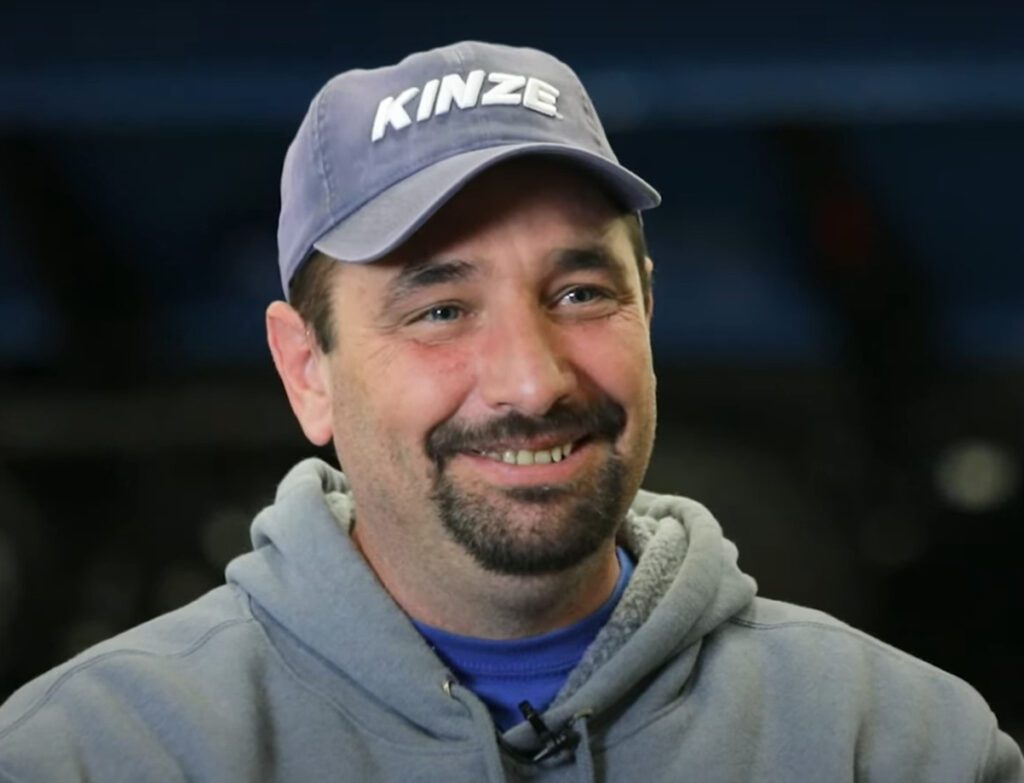
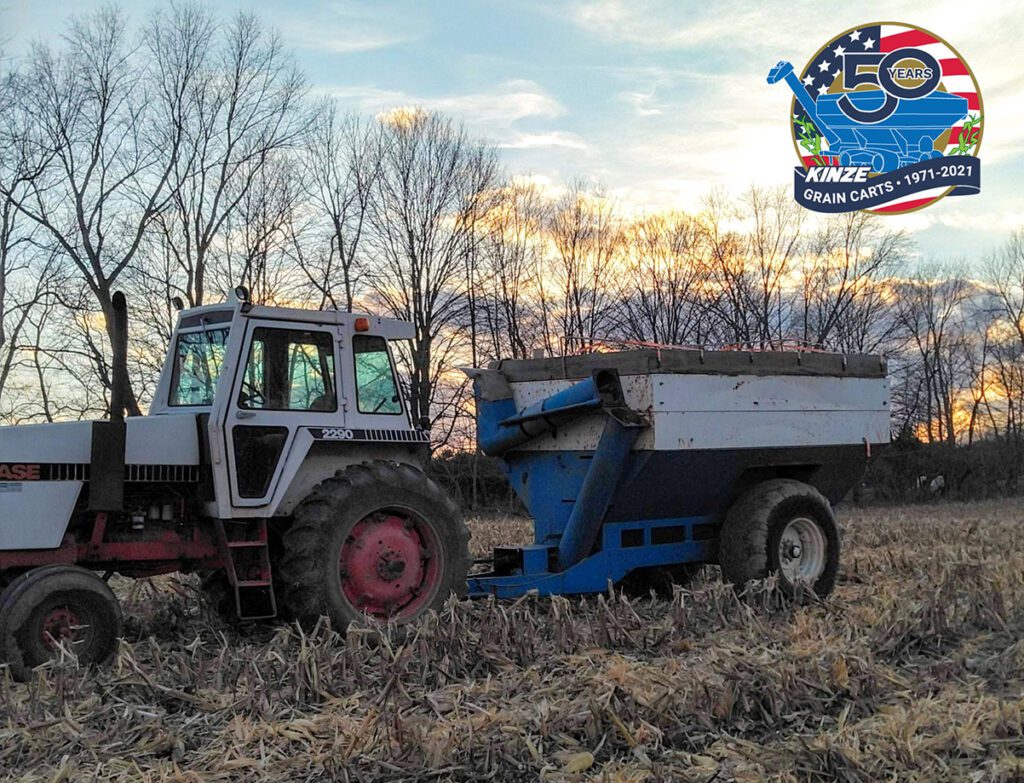
The other fortunate owner of a cart from the historic first run of Kinze grain carts is Jeremy Smart from Peebles, Ohio. His grain cart somehow made its way to Ohio where his brother-in-law purchased it at a farm sale about 10 years ago. After a few years, however, he needed a cart with a hydraulic auger fold, so he sold it to Jeremy.
Like Michael, Jeremy became aware of the age and significance of his cart when it was necessary to repair it. After running it for a few years, the augers wore out and some gears in the gearbox needed replacing. When replacement gears for a Kinze “400 grain cart” arrived, they were larger than the originals since the first-year gearboxes were different from those being used the next and following years.
“Apparently my ship has finally come in and they give out awards for keeping old equipment running,” Jeremy says cheekily. “Obviously it was manufactured well, and I am quite certain the original augers were in it until three years ago when I re-flighted them.”
When asked if he would ever get rid of his legacy cart, he responds, “Unless we can get me into a blue planter by trading [the cart] back in here, that will be my only way of getting rid of it. Keep that in mind,” he adds with a wink.
The Rest of the Story
The two-wheel cart established Kinze as a leading innovator in grain handling technology, a standing it has maintained with continuous product improvements. Through the years Kinze has introduced a number of grain cart innovations – such as SOF-TRAK rubber tracks (1988), conveyor unloading (1990), adjustable corner dual auger unloading (2012), and a successfully operating autonomous grain cart concept (2014) – that have raised the bar in operating performance and convenience.
Today, Kinze offers six different size carts, from 1050 to 1700 bushels, in three different configurations, and filled with practical features. To be sure, the welding shop business that Jon started in 1965, with its focus on the needs of the farmer, guides Kinze to provide practical and innovative grain handling solutions for farmers today.
Thank you to everyone who participated in the Oldest Running Cart Contest and sent in photos of your hard-working carts. Congratulations to Michael and Jeremy as co-winners and owners / operators of their legacy 50-year-old grain carts. And thank you to farmers everywhere for selflessly working every day to feed the world.
Story Notes
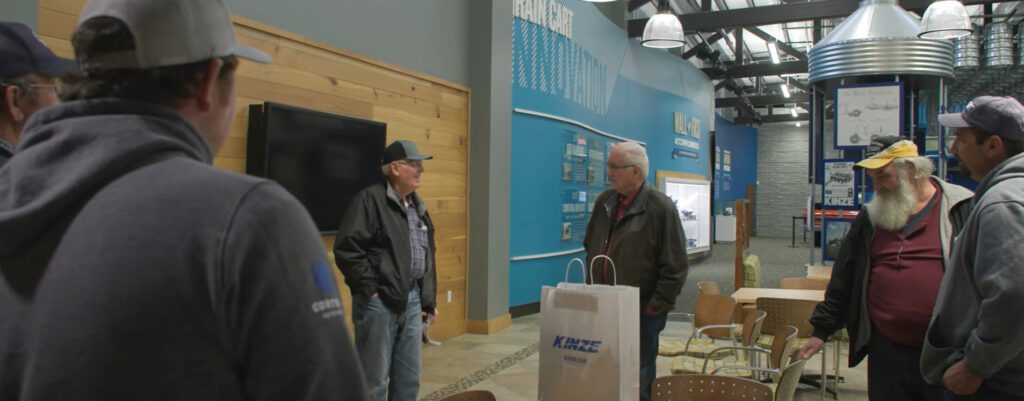
As the winners of the Grand Prize in the Oldest Running Cart Contest, Michael, Jeremy, and their guests traveled to Kinze’s corporate headquarters in Williamsburg, Iowa in March of 2022. There they enjoyed a private meet-and-greet with Jon Kinzenbaw, toured the Kinze Innovation Center and factory, and were treated to a private tour of Jon’s tractor collection. In addition, they received a signed copy of Jon’s book, 50 Years of Disruptive Innovation, and a promotional card to the Kinze store.
Dan Stadtmueller and his son, Darren, also attended the event after discovering he was the original owner of Michael’s grain cart. The original owner of Jeremy’s cart was not traceable.
Information and quotes about the carts were gathered during interviews conducted with Michael, Jeremy, and Dan during their visit to Kinze.
For More Information
Watch the video of Jeremy, Michael, and Dan telling the stories about their carts.
Read the blog about the history of the first grain cart.
Purchase the book, 50 Years of Disruptive Innovation, for the story of Jon’s early years and the history of Kinze.
